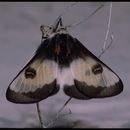Conservation Status
provided by University of Alberta Museums
Colonies of this species are very localized, and are known from only a few localities in Canada.
- license
- cc-by-nc
- copyright
- University of Alberta Museums
Cyclicity
provided by University of Alberta Museums
Probably late August to late September. The only AB date is in early September.
- license
- cc-by-nc
- copyright
- University of Alberta Museums
Distribution
provided by University of Alberta Museums
Eastern Alberta east to southwestern Manitoba, south to southwestern states.
- license
- cc-by-nc
- copyright
- University of Alberta Museums
General Description
provided by University of Alberta Museums
The black wings with the broad, white median band on both the fore- and hindwings, in combination with the tuft of reddish hair on the abdominal tip, make this striking moth unmistakable in Alberta.
- license
- cc-by-nc
- copyright
- University of Alberta Museums
Habitat
provided by University of Alberta Museums
Stabilized sand dunes with trembling aspen.
- license
- cc-by-nc
- copyright
- University of Alberta Museums
Life Cycle
provided by University of Alberta Museums
The eggs are deposited in bands on the twigs of the host plant or on plants near the hostplant, and likely overwinter.
- license
- cc-by-nc
- copyright
- University of Alberta Museums
Trophic Strategy
provided by University of Alberta Museums
A colony of larvae collected from Trembling Aspen near North Battleford, SK by the Forest Insect Survey were reared to maturity and are located in the Northern Forestry Centre, Edmonton.
- license
- cc-by-nc
- copyright
- University of Alberta Museums
Hemileuca nevadensis
provided by wikipedia EN
Hemileuca nevadensis, the Nevada buck moth, is a species in the family Saturniidae.
Description
The female tends to be larger than the male, while males have black abdomens with red tips. The upperside of the wing is creamy white with black edges, each wing has "eyes" or black dots.
Distribution
They range from the west coast all the way east to Wisconsin and Michigan. There have been a few sightings in New York, but not enough to confirm it as a localized species.
Life cycle
There is one brood between September and December during that time the adult will lay eggs in rings around the twigs of the host plant. Once the caterpillars are ready to pupate they spin loose cocoons in plant litter near their host plant.
Larval foods
The adults don't feed.
References

- license
- cc-by-sa-3.0
- copyright
- Wikipedia authors and editors
Hemileuca nevadensis: Brief Summary
provided by wikipedia EN
Hemileuca nevadensis, the Nevada buck moth, is a species in the family Saturniidae.
- license
- cc-by-sa-3.0
- copyright
- Wikipedia authors and editors

